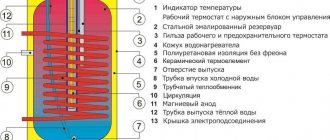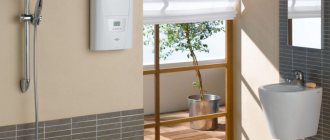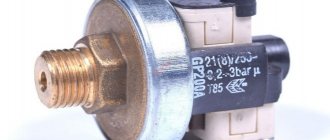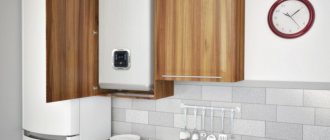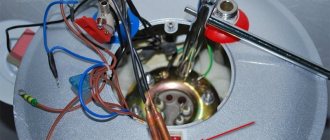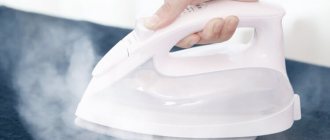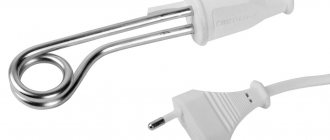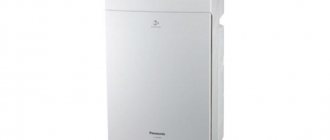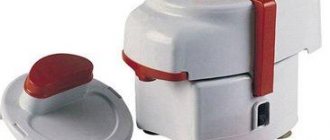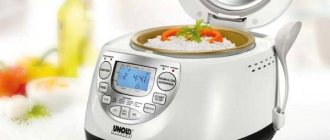No. 1. Main types of boilers
Water heaters can be electric or gas. The latter are popularly called columns and are used less and less due to the increased danger. Electric water heaters are usually called boilers . They are well known to many of us; they are characterized by quiet operation, ease of operation, durability and safety, if, of course, the choice was made correctly.
According to the type of heating, electric water heaters are:
- flow-through;
- cumulative.
Instantaneous electric water heaters
Boilers of this type are compact in size and allow you to heat water instantly. Tap water, in contact with the heating element, is heated and enters the tap already hot, i.e. there is no process of mixing it with cold water. Heating of water occurs instantly, since the power of the heating element is decent. Often, boilers of this type are used in apartments where there are frequent interruptions in the centralized supply of hot water. They do an excellent job of heating water for one water intake point. If you turn on hot water in two places at the same time, it may not have time to warm up - it all depends on the power.
The power of instantaneous water heaters ranges from 3 to 27 kW. In an apartment with a single-phase voltage of 220 V, you cannot use an 8 kW boiler. A flow-through boiler with a power of 3-8 kW heats 2-6 liters of water per minute, which is not so little - this will be enough for the household and hygienic needs of a small family.
For a private house with a three-phase voltage of 380 V, you can take a more powerful boiler. Then there will definitely be no problems with a lack of hot water.
Advantages of instantaneous boilers:
- compactness;
- fast water heating;
- The water is heated only when it is needed. Turn on the tap - warm water flows, turn off the tap - the water does not heat up, which means no electricity is consumed, which is the competitive advantage over storage boilers;
- hot water will not run out suddenly. In storage boilers, if the hot water reserves are used up, you will have to wait a long time for heating.
Minuses:
- high power backfires if the wiring in the house is not very good (for Khrushchev and other old houses this is a serious problem), and even if such a boiler is used frequently, the electricity bills will not please you. A storage boiler is more economical in this regard;
- water in a flow boiler may overheat, since it heats up very quickly, and mixing with cold water does not occur. In this case, the boiler will first release hot water, then warm and then cold water will flow from the tap, and only then normal operation will resume. This is why it is very important that the boiler has a heat limiter.
Instantaneous water heaters can be of two types:
- non -pressure It heats water only for one water intake point, so it must be located in close proximity to it. For city apartments this is not the most convenient option, but for dachas such a boiler is ideal;
- pressure _ Such a water heater is built into a water riser, so the device allows you to heat water for several water intake points at once.
a faucet water heater on sale , which can be considered the most simplified version of a non-pressure boiler.
Storage electric water heaters
In any case, a storage boiler will be larger than a flow boiler, since it is equipped with a tank in which already heated water is heated and stored. When someone turns on the tap, hot water from the boiler is mixed with cold water and sent through the faucet or shower head. As the water is consumed or cools, the device turns on the heating again. Tank volume ranges from a modest 10-30 liters to 150-200 liters . Whether such a water heater is installed on the wall or on the floor - it all depends on the size of the tank.
What volume of storage boiler is needed? It all depends on the family's needs for hot water. To wash, on average, one person spends 40-50 liters of water, but keep in mind that hot water from the water heater is mixed with cold tap water. Taking a shower uses less water than running a bath. When choosing the boiler volume, you can focus on the following data:
- a boiler with a volume of 50-80 liters is enough for a small family of up to 3 people to wash dishes and take a shower. In principle, you can take a bath if you heat the water in the boiler to the maximum;
- 80-100 l – option for a family of 4 people. Such a unit does not cost much more than a 50-liter boiler, but a larger tank will take longer to heat up;
- 100-150 l - boiler for a large family, which consists of 6 people. There is enough water for several washbasins, for a shower, and for filling a bathtub;
- Boilers with a volume of more than 150 liters are used, as a rule, in private homes, are installed on the floor and consume a decent amount of electricity.
It’s important not to go wrong with volume. If it turns out to be insufficient, there will be constant inconvenience, and if it is excessive, you will have to overpay and wait too long for heating.
Among the main advantages of storage boilers, we note:
- efficiency. An average boiler, suitable for a city apartment, consumes 1.5-3 kW of electricity during heating and can be connected to a regular 220 V network;
- one boiler, even not the largest volume, is enough to fully provide hot water to all water intake points in the apartment;
- durability.
The storage boiler immediately heats the entire volume of water in the tank, so the larger its capacity, the longer you will have to wait (a 30-liter tank will heat up in 1-1.5 hours, and a 120-liter tank will heat up for up to 4 hours). In addition, a suitable location still needs to be found for huge water heaters. Usually the boiler is located in the bathroom or toilet, so do not forget to take a tape measure before purchasing and measure what size equipment can fit in the bathroom so as not to interfere with free movement. Small-sized water heaters are produced not only in the usual vertical, but also in a horizontal form. Some manufacturers produce built-in models that can be placed in a cabinet under the sink.
Combined water heaters
This type of device combines the advantages of storage and instantaneous boilers. Small-sized combined water heaters weigh no more than 6 kg, are equipped with a tank with a volume of 10-30 liters and can operate in two modes. The choice of such models is not very wide.
Storage tank - what is the advantage
As a matter of fact, there are only two options for water heaters, which differ in the way they heat water.
1. Flow-through , and its name speaks for itself. It warms only a small volume of water at the moment when the flow passes through the heating element. The advantage of this design is the heating speed. And, in fact, it is the only one, because if the supply of cold water stops, you will not have hot water either.
2. Cumulative. Unlike a flow-through heater, storage-type equipment has a tank that is filled with water, and in household models its volume can reach 100 l (minimum 12 l). It takes time to heat such an amount of water, but you will have it in stock even when the water or electricity is turned off.
In addition, the boiler (the second name for storage-type heaters) does not consume electricity while you are using the already heated volume of water, which gives significant savings. This is its second and very significant advantage.
Appearance
Placement option in the kitchen
Many apartment owners are familiar with the problem of insufficient water heating when it is supplied centrally. Rather than constantly conflict with the company that provides such a service and write complaints, it is easier to abandon it altogether and install a small electric water heater.
Thanks to various shapes and compact sizes, you can always choose the appropriate option and place it in almost any size room. The main thing is to provide for the outlet of the cold water supply pipeline in the right place.
Option for placement in the bathroom
Note! If such equipment can be installed in an apartment, then for a cottage, country house, office, industrial premises, hairdressing salons and other small businesses whose owners do not want or cannot depend on the presence or absence of a centralized hot water supply, installing a boiler is simply an ideal solution.
No. 2. Heating element type
Heating elements are responsible for heating in boilers; spiral heating elements are used less often (they are more powerful, but if something happens, they are more difficult to repair).
Heating elements can be of two types:
- "wet";
- "dry".
From the name it's easy to understand who is who. “Wet” heating element is a copper heating element that is immersed in water and operates like a boiler. Such heating elements are typical for many storage and almost all instantaneous boilers. These are cheap devices, but due to direct contact of the heating element with water, scale quickly forms on it, which has high thermal insulation properties, due to which the heating element’s ability to heat water is reduced. You will have to constantly increase the temperature, and this will affect the service life of the boiler. It is noteworthy that the higher the heating temperature, the faster scale forms. In addition, a “wet” heating element is susceptible to electrochemical corrosion. If your apartment has a water filter installed, then in principle you can use a boiler of this type; it costs less. When working with hard water, be prepared to clean the heating element once every 3-4 months.
The “dry” (steatine) heating element is protected by a special flask and does not come into contact with water, so scale cannot form here. The heat transfer of such a heating element is much higher, and so is the service life, but a boiler with a similar heating element will cost 1.5-2 times more.
Atlantic boilers
A good example of a water heater with a “dry” heating element is the French Atlantic. Atlantic factories are located all over the world. Except China - that’s why Atlantic is often called the most “NON-Chinese” water heaters. Atlantic boilers are equipped with a proprietary soapstone heating element with a service life of up to 20 years. This is ten times longer than conventional inexpensive “wet” heating elements.
Due to the coating of the tank with proprietary enamel with titanium dioxide and a magnesium anode, scale practically does not settle in Atlantic boilers and rust does not appear. Therefore, Atlantic are also the quietest, most economical and reliable water heaters of all that are sold in Russia.
Atlantic work with all types of water and are provided with a maximum warranty on tanks - 7-8 years. And Atlantic does not need to be serviced annually, like most conventional Chinese manufacturers. And once every 2-3 years.
Storage water heaters can be equipped with one or two heating elements . All large-volume boilers, as well as models with a fast heating function, receive a second heating element.
No. 3. Boiler inner lining
The inner surface of the storage boiler tank constantly interacts with water, so it must be as resistant to corrosion as possible. Today, water heaters are available for sale in which the inner surface of the tank is made of the following materials:
- stainless steel;
- enamel coating;
- glass ceramics;
- titanium coating;
- plastic covering.
Boilers in which the tank has a plastic inner coating are the cheapest, but their reliability is questionable. Stainless steel tanks performed best . Manufacturers give them a 10-year guarantee, and some additionally carry out passivation, increasing the warranty period to 12 years. From the point of view of durability and reliability, such tanks are preferable, but they are not cheap. The most expensive boilers receive titanium coating , which allows you to extend their service life for several more years.
Tanks with an enamel coating are not much inferior to their stainless steel counterparts. Thanks to the addition of special additives to the enamel, it receives the same expansion coefficients as the steel from which the tank itself is made, so this coating will not crack when heated. The enamel coating is being improved day by day. Today you can find water heaters in which the enamel is coated with silver ions . Due to this, antibacterial and anti-corrosion properties are increased.
Some experts note that plastic, enamel and glass ceramics can suffer mechanical damage from temperature changes and when interacting with solid particles found in tap water. Still, enamel and glass-ceramic coatings are not the worst option for a boiler, although they are incomparable to stainless steel.
On the other hand, no matter how strong the inner coating of the tank is, the weak points are still the same in all cases. These are the welds that begin to rust first. To prevent corrosion of the tank and “wet” heating element, the design of all modern boilers includes anodic protection . For this, a magnesium, titanium or aluminum anode is used, and a tank acts as a cathode. The anode can be called a consumable material. It is better to change it every few years, while simultaneously cleaning the heating element and flushing the tank.
Remember that a high-quality boiler, manufactured according to all the rules, cannot be cheap. The absence of a warranty or a very short period should also indicate that the manufacturer, to put it mildly, is not confident in the quality of its products and wants to quickly relieve itself of responsibility for it.
What materials are tanks made of and features of their maintenance?
Water tank material:
- Stainless steel. Such models are more resistant to corrosion and reliable. However, their production is more expensive, which affects the final cost.
- Carbon steel. To prevent corrosion, the inside is coated with hot-applied enamel. In most cases, bioglass enamel is used, as well as coatings interspersed with silver or titanium.
To know which storage water heater to choose, please note: steel also varies in quality and depends on the amount of alloying elements.
It is mandatory to install a magnesium anode for cathodic protection, which periodically needs to be replaced. You also need regular checks (every 1-2 years) of the condition of the inside of the boiler.
No. 4. Boiler tank shape
When deciding which boiler to choose, you can get so carried away by studying data on power, volume and material that you forget about much more obvious things. We are talking about the shape of the body. There are few options here, the body can be:
- round;
- rectangular.
Round barrel boilers tend to cost less (as they are easier to manufacture) but take up more space. This is the most popular version. Devices with a rectangular tank will save space, since they can be installed in a corner, niche, on the edge of a wall, or even hidden in a cabinet. Moreover, due to their shape, such models are equipped with a thicker layer of thermal insulation. There are also so-called slim models , in which the diameter or one of the sides is smaller than in standard devices. Before purchasing, it is very important to decide exactly where the boiler will be located and how much space is available for its installation.
As for color , there are few options. The most popular and win-win option is a white body. Gray and silver models are also in demand.
No. 5. Vertical and horizontal water heaters
Depending on the installation features, boilers can be:
- vertical;
- horizontal;
- universal.
Vertical and horizontal boilers differ in their design features and the location of the heating element, which can be attached to the bottom plate or side surface of the tank. It is not recommended to install vertical water heaters horizontally - their performance may decrease, and vice versa.
If space in the bathroom is limited, then it is better to opt for a horizontal model. Such a boiler is mounted right under the ceiling, takes up a minimum of space and is not conspicuous. On the other hand, a horizontal boiler is a little more expensive and more difficult to install and maintain.
Universal boilers are attractive because they can be mounted in any way without losing functionality or performance.
No. 6. Boiler control system
You can set the necessary operating parameters and control the heating of water in the boiler in one of two ways:
- mechanical control. The simplest, cheapest and most practical option. The degree of water heating is set by a rotary lever, which is located on the bottom of the boiler. On the boiler itself there is a small window with an arrow, with which you can control the current temperature of the water in the tank. Everything is extremely simple - there is practically nothing to break here. The downside is that it is difficult to accurately adjust the water temperature, as well as, in principle, to determine the current degree of heating;
- electronic control. Represented by a display and physical or touch buttons. The user gets the opportunity not only to set the desired heating temperature with an accuracy of a degree, but also to remember heating modes, carry out diagnostics, start an economical mode, etc. Such boilers are more expensive and, moreover, sensitive to voltage changes in the network.
Varieties
To make the right choice, you need to carefully study each type of electric water heater, taking into account all the positive and negative aspects. Let's look at them in more detail.
There are two types of water heaters: instantaneous and storage.
In flow-through systems, water enters the heat exchanger and is heated there. It takes no more than 30 seconds. They are distinguished by high power consumption, which is not always convenient and profitable. In cheap models, the outlet temperature directly depends on the inlet temperature. If you choose an electronically controlled water heater, the temperature will be adjusted automatically.
If it is necessary to use a large amount of water, the most optimal would be a storage-type EWH with a water supply of at least 50 liters . This is the average daily water consumption per person, which includes a quick shower, washing dishes and light laundry.
Instantaneous water heaters and small storage heaters are often electric; gas ones are less common. As a rule, all household models have a wall mount.
No. 7. Additional functions, equipment, installation
When choosing an electric water heater, it doesn’t hurt to pay attention to its configuration and additional options:
- For a storage boiler, a layer of thermal insulation . It must be at least 35 mm so that the water in the tank remains warm for a long time, saving the family budget. Foamed polyurethane is an order of magnitude superior to foam rubber and will be the material of choice;
- overheating protection function is an important component of your safety. If the boiler will be used in the country, then it is worth looking at a model with a freeze prevention mode;
- The timer will allow heating to be carried out at night, when electricity is cheaper. Such models are not much more expensive than regular ones and will be useful for those who have a two-tariff meter installed;
- Each boiler has a certain degree of protection against moisture . If the device will be used in a bathroom, it is better to take a model with IP44; in other cases, the minimum level of protection IP23 will be sufficient;
- As a rule, normal manufacturers equip their boilers with a power cable and a blast valve. The latter is installed at the point where the water pipe enters the boiler and prevents excess pressure. It will also not hurt to have factory brackets, thanks to which the boiler will be mounted;
- It is worth taking care of the presence of a bushing to isolate stray currents.
Most likely, you will have to purchase additional water pipes, valves, connecting fittings, and sometimes fasteners. If the water in the region is oversaturated with salts, it would not hurt to install a filter.
The installation of the boiler should be carried out by a professional who is able to strictly follow the instructions and the requirements specified therein. Otherwise, problems may arise with warranty repairs of the equipment. It is important to ensure proper grounding and check whether the pressure in the water supply corresponds to the operating pressure of the boiler: if cold water is supplied with higher pressure than it should, you will have to install a pressure reducer. Finally, we note that there must be enough free space in front of the boiler.
Instantaneous water heaters
If you do not plan to completely abandon centralized water supply, but intend to heat water from time to time (scheduled shutdown, or urgent repairs), the most economical choice is a tankless water heater. Here is an undeniable “plus”: it only heats up during use.
In instantaneous electric water heaters, water circulates freely through the heat exchanger. As soon as the tap opens, the heating element turns on and the water comes out hot. Under the outer casing are:
- open or closed (heating element in a plastic or brass tube) water heating element;
- flow switch and temperature sensor,
- power regulator.
Due to the lack of a storage tank, instantaneous boilers have small dimensions, allowing you to install an EWH with maximum savings in usable space - even under the sink or ceiling.
This heater is enough to wash dishes, wash your face or do laundry. Suitable for improving life outside the city.
